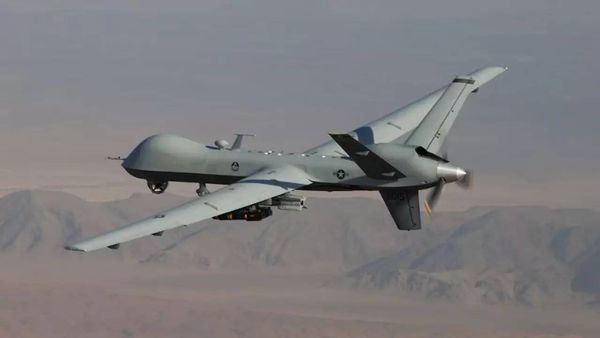
A US drone entered the Black Sea after a collision with a Russian fighter jet on Tuesday, in what appears to have been the first direct encounter between the world’s leading nuclear powers since the Ukraine war began. Here is everything you need to know:
What happened and why does it matter?
Declassified footage released by the Pentagon on Thursday showed an Su-27 Flanker jet making two exceptionally close passes of the drone, spraying fuel in front of it – a harassment tactic that US experts say has not been seen before. On the second pass, the Su-27 moves so close to the MQ-9 Reaper that the image briefly becomes pixelated, indicating a collision had happened. When the camera recovers, a bent propeller wing can be seen – damage sufficiently serious for the US air force to bring the drone down.
The Russian and US defence ministers and military chiefs held rare phone conversations on Wednesday to discuss the incident, which was the first recorded collision of a US and Russian or Soviet aircraft since the second world war.
What has the US said about the incident?
US officials briefed that the footage “absolutely confirms” there was a collision and dumping of fuel – but they added it did not confirm the Russian pilot’s intent and whether the pilot intended to strike the Reaper.
“There is a pattern of behaviour recently where there is a little bit more aggressive actions being conducted by the Russians,” Gen Mark Milley, the chair of the US joint chiefs of staff, said on Wednesday. Milley said it was clear that the interception and harassment of the drone by Russian jets was intentional, but it was unclear whether the Russian pilots meant to slam their aircraft into the drone – a move that could also put them at risk.
What has Russia said?
Before the Pentagon released the footage, Russia had denied any collision and said the drone crashed after making “sharp manoeuvres”, having “provocatively” flown close to Russian airspace near Crimea, which Moscow forcibly annexed from Ukraine in 2014.
Sergei Shoigu, the Russian defence minister, told his US counterpart, Lloyd Austin, that US drone flights near Crimea’s coast “were provocative in nature” and could lead to “an escalation … in the Black Sea zone,” a ministry statement said.
What sort of drone was it?
The MQ-9 Reaper is a large uncrewed aircraft manufactured by the military contractor General Atomics. It is remotely operated by a two-person team, consisting of a pilot and an aircrew member who operates sensors and guides weapons.
The aircraft is 11 metres long with a wingspan of more than 22 metres. The US air force says its primary use is as “an intelligence-collection asset”, while also highlighting its “unique capability to perform” precision strikes against “high-value and time-sensitive targets”. Reapers can carry as many as 16 Hellfire missiles, equivalent to the payload capacity of an Apache helicopter.
Reapers, like other unmanned aerial vehicles, are able to fly at an altitude of 50,000ft (15km) and can loiter over targets for about 24 hours, making them useful for surveillance missions. Crucially, all of this occurs with a flight crew that remains based in the US, away from danger.
Over the 2018 calendar year, MQ-9 Reapers flew a total of 325,000 hours for the US air force, 91% of which was in support of combat operations.
Has this sort of thing happened before?
This is not the first time Russian aircraft have flown so close to US aircraft in the Black Sea that it has prompted the Pentagon to publicly condemn the incident for putting the crews at risk. In 2020, Russian jets crossed in front of a B-52 bomber that was flying over the Black Sea, and flew as close as 100ft (30 metres) in front of the bomber’s nose, causing turbulence.
Russian jets have also buzzed US warships during exercises in the Black Sea. In 2021, Russian warplanes buzzed the USS Donald Cook, a navy destroyer, which had been taking part in a major exercise. Until Russia’s invasion last year of Ukraine, US warships more frequently deployed to the Black Sea in response to Russia’s 2014 attack on Crimea.
Associated Press and Reuters contributed to this report










